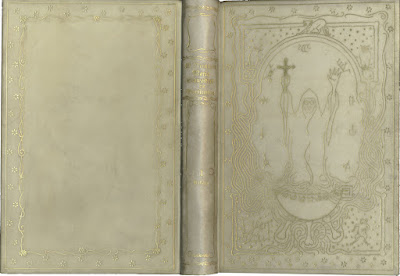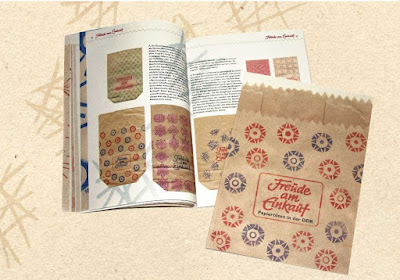Back in August 2012, Henry Hebert who was at the time a NBSS student coined a new term,
fancied-up books. By this he meant trade books that were disbound in varying degrees and then rebound in more attractive bindings, whether paper, cloth, leather, ... Essentially budget design bindings, and we've all done it. Reading some new additions to my collection, I came upon what could be considered the ur-type of this.
With industrialization, bookbinding became more and more simplified with consequences for aesthetics and structural integrity. Away from sewing on raised cords and lacing those through the boards, the cords became thinner, were sewn in, sewing became mechanized (with staples being used like sewing in Germany), case binding developed, and some will say devolved from there. In Germany, the arts and crafts movement contributed to a return to sounder structure and better design, a movement the larger binderies also appropriated with the addition of extra binding departments that produced works on par with those of hand/fine binders. Leading binderies in Germany, these located in Berlin, and the book capitol of Leipzig were: E.A. Enders, Fritzsche, Hübel & Denck, Lüderitz & Bauer, Spamer, Wübben, and W. Collin among others.
Hermann Nitz (1881-1965) was a student of Paul Adams and Paul Kersten who worked as a craft bookbinder at Hübel & Denck and Spamer, and became a member of the Jakob-Krause-Bund (J-K-B) and the Meister der Einbandkunst (MDE). Despite this fine craft pedigree, he dedicated his life to working in large trade binderies where he merged the work of machines and fine craft bookbinding to create durable and pleasing bindings. He also taught and wrote on this topic, including about materials, industrial binding processes, and innovations to merge the craft and trade. This tension allegedly created animosities with peers, so that he left the MDE.
*
One of these innovations was the Kombinationseinband, that combined machine sewing with simplified forwarding to give the appearance of an extra binding at lower cost, and without sacrificing quality. It was first described in this pamphlet
Über einen neuen Einband-Typ published by Spamer in 1923.
 |
| Cover for Hermann Nitz's Über einen neuen Einband-Typ (About a New Binding Structure) |
 |
Spamer's Bindery in Leipzig: Most modern commercial bindery, 250 machines, 400 employees.
All kinds of bindings: Extra binding department for hand-binding, decorated papers, folders
At right an example of a handbound book. Other illustrations depict these and Kombinationseinbände
so comparisons can be made. |
So, something about Spamers Kombination Bindings...
So, what was it. From the pamphlet, "the distinguishing characteristic of this style is the board attachment by hand with a 90° joint before covering," essentially extra binding. Nitz further describes the book being sewn on a modified sewing machine hemp fibers rather than gauze, backing to 90°, stuck-on endbands, covering by hand, and gilding using the blocking press and dies. At additional costs, the book might be hand-sewn, receive hand-sewn endbands, and other details. The binding style was developed for smaller or larger print runs of the classics, literature, encyclopedia, etc, in full or quarter leather, something these simplifications made possible. The pamphlet
can also be viewed here, and features numerous images of books using this structure.
The style was also described by Nitz in his
Die Technik des Bucheinbandes (1931), and Heinrich Luers'
Das Fachwissen des Buchbinders (1943, 1946 (271)) where it is described as the Kombinationsfranzband, linking it to the extra binding. As a formal binding manual, it provided greater detail on the process, including for gilding. In it, after preparing the textblock and attaching the boards, a spine stiffener with raised false bands if desired is prepared, and pasted to the covering leather that has been pared, working the bands... When dry it is gilt in the blocking/stamping press..., and the binding then completed per the style.
Die Technik des Bucheinbandes, a work that like Collin's 1922
Pressbengel (
The Bone Folder) described bookbinding for bibliophiles and was issued in an edition of 500 copies by the Gesellschaft der Bibliophilen, Berlin. In contrast to Collin's dialog format, his is written more like a manual but in lay terms. A contemporary counterpart would be Jamie Kamph's
A Collector's Guide to Bookbinding (1982) in an edition of 250 copies. More in a later post...

































